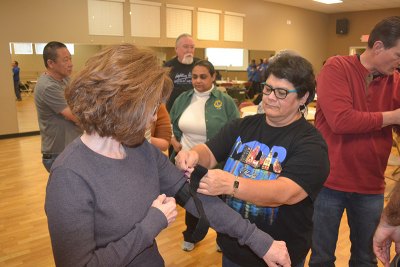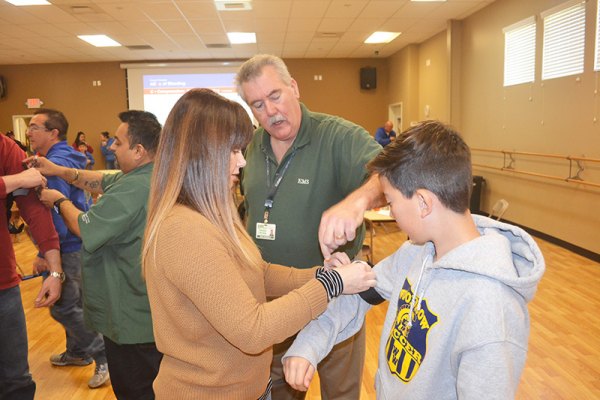Las Vegas shooting survivor Lacie Kandarian brings unique insight to 'Active Shooter' forum
When it was all over 58 people were dead and 851 injured in what has since become this country’s worse mass shooting.

Kandarian and her two best friends survived the ordeal, but there were many moments during the terrifying night that she didn’t think she would. The 37-year-old data analyst with Kaweah-Delta’s Sequoia Regional Cancer Center ultimately lived to see her family, including her two boys: 13-year-old Kameron and 9-year-old Kouper.
She survived to tell her story, not realizing at the time that her words and her memories of that night just might make a difference someday, somewhere, somehow.
And they have.
On Saturday, Feb. 24, at the Lemoore Cinnamon Recreation Complex, Kandarian summoned the will to speak to about 50 people about her experience during a gathering organized and hosted by the Kings Lions Club to inform residents about the dangers of “active shooters” and its aftermath.
Lemoore Mayor Ray Madrigal, who served 30 years with the California Highway Patrol, ending his career as a captain and area commander in Mendocino County, helped organize the event along with fellow Lion and Reedley High School Learning Director Joe Arruda.
“One of our club’s initiatives has been helping the community with emergency preparedness,” said Madrigal. “So, Joe Arruda and I who have had some training in Active Shooter, thought we should do that and then take it a step further with 'Stop the Bleed' and just help our community become a safer place with this very simple training.”
Madrigal said he was pleased with the turnout Saturday morning as Lions' members and others participated in the active shooter presentation and a two-hour “Stop the Bleeding” program. “We were planning for about 50 persons just because of the room size, and we got just about everybody that signed up to show up so that just tells me how interested people are in this topic. I think we’re going to be organizing some more events and might even have some opportunities to partner with the (Kings County) Department of Public Health.”
Arruda, who lives in Lemoore, is his school district’s expert on active shooters. “As a learning director I’m in charge of safety and security,” he said, “so the district sent me to (training), and I became an active shooter instructor.”
How relevant is the training? “It’s very relevant. We’ve been teaching run, hide, fight now for seven years because of all the shootings, but obviously, with all the heightened alert and with what’s going on, this is very relevant.”
Madrigal and Arruda spent the first two hours Saturday morning telling the rapt audience what they needed to be aware of when dealing with an active shooter. The later session dealt with treating victims. It was led by Central California Emergency EMS Coordinator Curtis Jack, who guided the 50 or so in attendance as to the steps needed to help shooting victims. He offered hands-on instruction on using a tourniquet and “packing” a wound – a procedure to stop excessive bleeding.
Kandarian was a featured speaker during the opening session, and in an interview with The Leader, she shared her story about what happened on that terrifying October night.
“We were standing kind of towards the back,” she remembered as if it were yesterday, “but in a direction where we were kind of not close to the stage but a distance, and there were some police officers (near us). When we heard the loud noise we kind of thought it was fireworks, but the concert wasn’t over, and they (Police) didn’t seem to flinch, so we didn’t think anything of it.”
Shortly though, she began to comprehend what was happening. “And then it just became rapid fire. Once they (police) took off, we turned around and took off under shelter, under like a tent, but obviously, we knew that standing in that tent wasn’t going to be any help – it wasn’t going to help us.
“From there we just moved, and when we thought it was safe, we just kept moving. The entire time there were shots continuing to rain down on the concert goers. It lasted it seemed like forever. It seemed probably like 10 minutes of just stop and go, stop and go,” recalled Kandarian.
“I thought I was going to die at that venue,” as she calmly related the experience. “That was it.”
She and her friends sat tight. “We were able to stay together, and at one point we just kind of looked at one another and said this is it, but we’re going to keep moving. At one point we crawled through these metal – they were holding up the tent we crawled through – to get to another side of the tent to keep going, and then we stayed behind some trailers for a period of time. Then we waited until we were able to get through. Then there was a police officer yelling ‘come, come, come’ so then we would all go in bunches out the back.”
As they attempted to flee the gunfire, which rained down on them for several minutes, Kandarian and her friends saw the carnage. “There were bodies on the ground. There were people screaming and yelling and people screaming on their cell phones. We just saw chaos.”
They finally made their way to safety in the nearby Tropicana Hotel, which was rapidly becoming a staging ground for the wounded and fleeing concertgoers. They were told to enter the hotel, knock on doors and find shelter, which they did. They eventually found refuge in a room with about ten other persons escaping the shooting.
“When we got to the Tropicana I called my parents to tell them goodbye and to keep my kids safe. I didn’t think I was leaving the Tropicana.”
She said the Tropicana’s lobby resembled a war zone.
“There were people in the Tropicana just bleeding on the ground. We asked at one point do you need help? We stayed on lockdown in the Tropicana for a few hours, and then once the lockdown was over we went back to our hotel across the street which had been on lockdown as well we were told, and we drove out of there.”
It was a somber trip to Hanford. “I went straight home. I don’t think it sunk in for a while. I went back to work the next day,” she said. “If it wasn’t for my friends and family I don’t think … they were all calling and texting. I wanted to make sure that my kids knew that things happen, but you can’t let it control your life.”
Saturday’s program was the second time Kandarian has participated in an active shooter program, and she thinks they’re worth it. “I wanted to make sure my son – with everything that’s going on – I thought it was important to educate my son and make sure that he understands that this is a possibility.”
Also in attendance, Saturday morning was Kings County Public Emergency Planner Annette Burgos. She said educational events like “Stop the Blood” and “Active Shooter” are an essential resource in helping residents understand and deal with the consequences of shootings and their aftermath.
“Of course, here our main focus is public health and being able to help the people here in our community,” she said. “So, being able to look at this kind of thing … and be a resource for people so they can come to us and be able to point them in the right direction – to where they can go and get trained and make sure more people are safe. As far as things like ‘Stop the Bleed,’ it’s kind of one of those things, everyone should know how to do it. We hope no one ever has to, but it’s a good tool to have.”
Dispatches
- Veterans Day Parade slated for downtown Lemoore on Nov. 11 at 6 p.m.
- West Hills Coalinga signs safety contract, hires Officer Brady Kaiser
- Kings County, Hanford chambers after two-year downtime, honor safety workers
- West Hills College Lemoore hosts monthly food distribution as over 200 vehicles show up
- Perfect evening for 'Pomp and Circumstance' at Lemoore High School Graduation
- Kings County COVID-19 mask requirement expires for fully vaccinated
_0.jpg)

.jpg)





